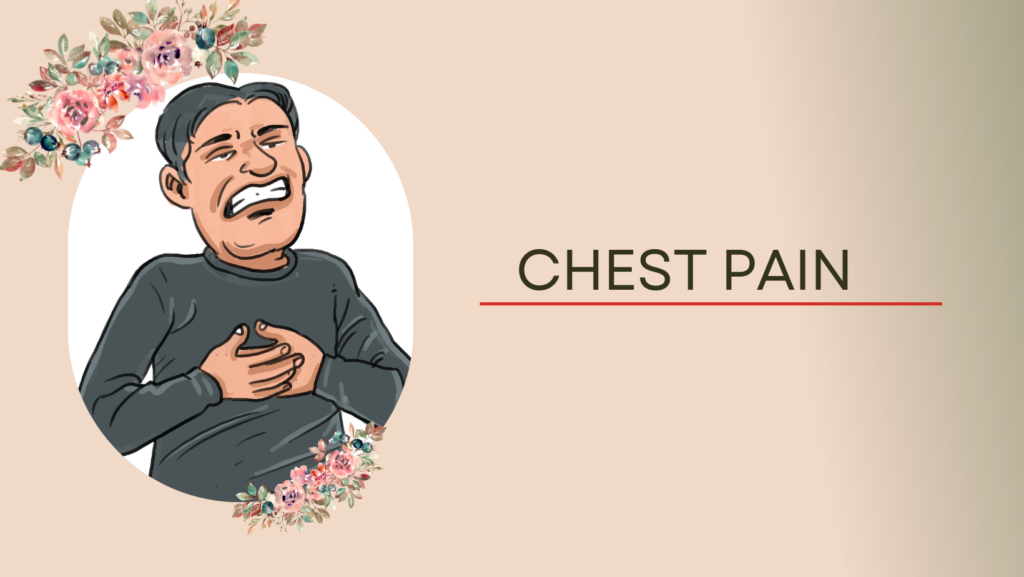Chest pain
Chest pain.
Definition: Chest pain is a common presentation of cardiac disease, but can also be a manifestation of anxiety or disease of the lungs, the musculoskeletal or gastrointestinal system.
We have describe in article.
Causes of chest pain
Features of angina chest pain
Features of myocardial infarction/MI chest pain
features of pericarditis chest pain

Causes of chest pain:
A. Cardiac:
- Myocardial ischaemia (angina).
- Myocardial infarction.
- Myocardititis
- Pericarditis. 5 Mitral valve prolapse.
B. Oesophageal :
- Oesophagitis
- Oesophageal spasm
C. Lungs/pleura:
- Pulmonary embolism
- Malignancy.
- Bronchospasm
- Pulmonary infarct
- Pneumonia.
- Tuberculosis
- Pneumothorax.
D. Musculoskeletal:
- Osteoarthritis.
- Rib fracture/injury.
- Intercostal muscle injury
- Costrocondritis.
- Epidemic myalgia.
E. Neurological:
- Prolapse intervertebral disk.
- Herpes zoster.
- Thoracic outlet syndrome.
Features of angina chest pain:
Site: Centre of the chest
Mede of onset : Builds up gradually in proportion to the intensity of exertion.
Character: Patient describes angina as a tightness or heaviness. The victim may complain discomfort rather than pain
Radiation: It may radiate to either or both arms, to the throat or jaw and less commonly to the back or epigastrium .
Associated symptoms: Angina is commonly accompanied by a feeling of breathlessness.
Timing/deration: Angina is a short-lived discomfort, usually lasting less than 5-10 minutes.
Aggravating/exacerbating factors: It is precipitated by conditions which temporarily increase myocardial oxygen demand such as exertion, emotional excitement, cold weather, exercise after meal.
Relieving factory: Rest or taking sublingual glyceryl-tri-nitrate (GTN).
Severity: It is usually not severe
Features of myocardial infarction/MI Chest Pain:
Site: Centre of the chest.
Mode of onset: Takes several minutes or even longer to develop.
Character: Dull, constricting, choking or heavy and is usually described as squeezing, crushing buming or aching
Radiation: It may radiate to either or both arms, to the throat or jaw and less commonly to the back or epigastrium.
Associated symptoms: Feeling of breathlessness, autonomic symptoms such as profuse sweat nausea, vomiting, palpitation, anxiety.
Timing/duration: Persists for prolonged duration.
Aggravating/exacerbating factors: It is precipitated by conditions which temporarily increase myocardial oxygen demand such as exertion, emotional excitement, cold weather, exercise after meal
Relieving factors: Not relieved by rest or taking sublingual glyceryl-tri-nitrate (GTN).
Severity: It is usually severe and patient feels fear of death.
features of pericarditis Chest Pain:
Site: Retrosternal.
Radiation: Radiates to left shoulder and back.
Prodrome: May be preceded by viral illness.
Onset: No obvious initial precipitating factor, tends to fluctuate in intensity.
Nature: May be stabbing or raw-like sand paper. Often described as sharp, rarely as tight or heavy.
Aggravating factor: Changes in posture, respiration.
Relieving factor: Analgesics especially NSAIDS.
Associated feature: Pericardial rub.

I am not sure where you are getting your info, but good topic. I needs to spend a while studying much more or understanding more. Thank you for fantastic information I used to be on the lookout for this info for my mission.
Wow that was unusual. I just wrote an incredibly long comment but after I clicked submit my comment didn’t appear. Grrrr… well I’m not writing all that over again. Regardless, just wanted to say great blog!